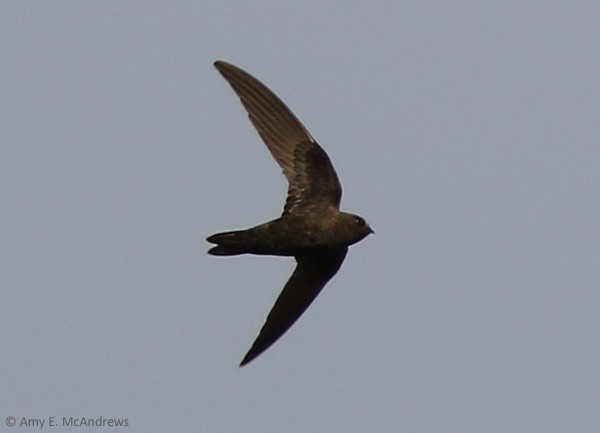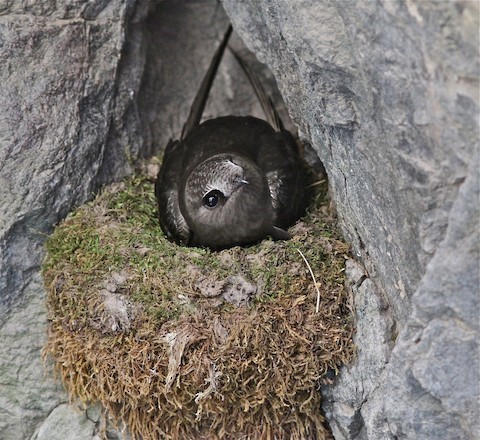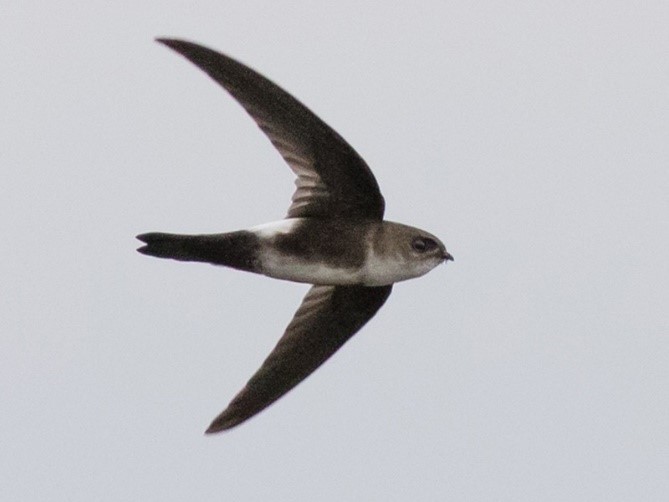Apodidae: Swifts
The swifts are a large family of specialized aerial insectivores that have long, finlike wings and torpedolike bodies. They are the most aerial of birds; most swift species are rarely seen perched, and some reportedly sleep in flight during certain stages of their life cycle. Except when nesting, they typically spend their daylight hours in constant motion, harvesting insects on the wing, and roost at night in the concealment of caves, behind waterfalls, or in hollowed-out tree snags (or analogous human constructions such as chimneys), which are also the places where they build their nests.
Most swifts share roughly the same body-plan, often described as a cigar with wings. Though similar to the swallows with whom they share the air, swifts are more fully adapted to fast and continuous flight. Their torpedolike bodies appear optimized for aerodynamics, round-headed tubular packages with no distinct contours between the head and the tail. Their wings are rigid, with short arms and extra-long primaries—in some species the longest primaries exceed the length of the bird itself does from bill to tail.
Swifts are extremely sociable. Most species breed colonially and live in flocks all-day and all-year. Swift flocks often include multiple species, as they tend to follow similar types of conditions to find similar types of prey.
Insects are the only major food source compatible with swifts’ lifestyle, which requires continuous availability of flying insects. As a result, a majority of swift species are tropical and most of the remaining species that occur in temperate climates are exclusively summer visitors. Among the few that remain for winter in areas that regularly freeze, such as the White-throated Swift (Aeronautes saxatalis) of western North America, some type of hibernation or metabolic rate reduction is apparently required.
Identification
Based solely on visible and audible clues, swifts are largely unidentifiable to most observers, so context is usually a central factor in identification. In most locations, only one or a handful of swift species can be expected to occur regularly. But swifts are among the global champions of long-distance wandering, so geography does not narrow down the possibilities to the extent that most observers presume.
Most swifts look more or less alike and the vast majority of species differ only subtly in size, shape, and shading from several closely related species. Moreover, most swift species can vary significantly in appearance doe to lighting, molt-stage, and posture, so their appearances are often unreliable for identification unless interpreted with an understanding of the relevant variables.
Taxonomy
Based on anatomy, supported by genetic analyses, swifts are divided into two families: a small group of treeswifts (Hemiprocnidae) and the majority, known simply as swifts (Apodidae), which include four major lineages. Among these lineages, one is considered its own subfamily, and the others are ranked as tribes within a second subfamily, as follows:
Cypseloidinae: Primitive swifts (13 species)
Apodinae: Modern swifts (100 to 117 species)
Collocalini: Swiftlets (42 to 43 species)
Chaeturini: Needletails (26 to 36 species)
Apodini: Typical swifts (32 to 38 species)
As currently understood, therefore, the Apodidae comprise somewhere in the range of 113 to 130 species.
Species
Spot-fronted Swift (Cypseloides cherriei)
White-chinned Swift (Cypseloides cryptus)
White-fronted Swift (Cypseloides storeri)
American Black Swift (Cypseloides niger)
White-chested Swift (Cypseloides lemosi)
Rothschild’s Swift (Cypseloides rothschildi)
Sooty Swift (Cypseloides fumigatus)
Great Dusky Swift (Cypseloides senex)
Chestnut-collared Swift (Streptoprocne rutila)
Tepui Swift (Streptoprocne phelpsi)
White-collared Swift (Streptoprocne zonaris)
Biscutate Swift (Streptoprocne biscutata)
White-naped Swift (Streptoprocne semicollaris)
Pygmy Swiftlet (Collocalia troglodytes)
Tenggara Swiftlet (Collocalia sumbawae)
Bornean Swiftlet (Collocalia dodgei)
Cave Swiftlet (Collocalia linchi)
Christmas Island Swiftlet (Collocalia natalis)
Plume-toed Swiftlet (Collocalia affinis)
Ridgetop Swiftlet (Collocalia isonota)
Gray-rumped Swiftlet (Collocalia marginata)
Drab Swiftlet (Collocalia neglecta)
Glossy Swiftlet (Collocalia esculenta)
Satin Swiftlet (Collocalia uropygialis)
Giant Swiftlet (Hydrochous gigas)
Three-toed Swiftlet (Hydrochous papuensis)
Black-nest Swiftlet (Aerodramus maximus)
Indian Swiftlet (Aerodramus unicolor)
Himalayan Swiftlet (Aerodramus brevirostris)
“Himalayan Swiftlet” (A. b. brevirostris)
“Indochinese Swiftlet” (A. b. rogersi)
Volcano Swiftlet (Aerodramus vulcanorum)
Whitehead’s Swiftlet (Aerodramus whiteheadi)
Bare-legged Swiftlet (Aerodramus nuditarsus)
Mayr’s Swiftlet (Aerodramus orientalis)
Halmahera Swiftlet (Aerodramus infuscatus)
Sulawesi Swiftlet (Aerodramus sororum)
Seram Swiftlet (Aerodramus ceramensis)
Mountain Swiftlet (Aerodramus hirundinaceus)
Australian Swiftlet (Aerodramus terraereginae)
Uniform Swiftlet (Aerodramus vanikorensis)
Marquesan Swiftlet (Aerodramus ocistus)
Tahiti Swiftlet (Aerodramus leucophaeus)
Atiu Swiftlet (Aerodramus sawtelli)
Caroline Islands Swiftlet (Aerodramus inquietus)
Palau Swiftlet (Aerodramus pelewensis)
Mariana Swiftlet (Aerodramus bartschi)
Ameline Swiftlet (Aerodramus amelis)
Philippine Swiftlet (Aerodramus mearnsi)
White-rumped Swiftlet (Aerodramus spodiopygius)
Seychelles Swiftlet (Aerodramus elaphrus)
Mascarene Swiftlet (Aerodramus francicus)
Germain’s Swiftlet (Aerodramus germani)
White-nest Swiftlet (Aerodramus fuciphagus)
Mossy-nest Swiftlet (Aerodramus salangana)
Scarce Swift (Schoutedenapus myoptilus)
Schouteden’s Swift (Schoutedenapus schoutedeni)
Philippine Spinetail (Mearnsia picina)
Papuan Spinetail (Mearnsia novaeguineae)
Malagasy Spinetail (Zoonavena grandidieri)
São Tomé Spinetail (Zoonavena thomensis)
White-rumped Spinetail (Zoonavena sylvatica)
Mottled Spinetail (Telacanthura ussheri)
Black Spinetail (Telacanthura melanopygia)
Silver-rumped Spinetail (Rhaphidura leucopygialis)
Sabine’s Spinetail (Rhaphidura sabini)
Cassin’s Spinetail (Neafrapus cassini)
Böhm’s Spinetail (Neafrapus boehmi)
White-throated Needletail (Hirundapus caudacutus)
Silver-backed Needletail (Hirundapus cochinchinensis)
Brown-backed Needletail (Hirundapus giganteus)
Purple Needletail (Hirundapus celebensis)
Lesser Antillean Swift (Chaetura martinica)
Band-rumped Swift (Chaetura spinicaudus)
“Panamanian Swift” (C. s. aetherodroma)
“Band-rumped Swift” (C. s. spinicaudus)
“Central Brazilian Swift” (C. s. aethalea)
Costa Rican Swift (Chaetura fumosa)
Gray-rumped Swift (Chaetura cinereiventris)
“Nicaraguan Swift” (C. c. phaeopygos)
“Ecuadorian Swift” (C. c. occidentalis)
“Sclater’s Swift” (C. c. sclateri)
“Gray-rumped Swift” (C. c. cinereiventris)
Pale-rumped Swift (Chaetura egregia)
Vaux’s Swift (Chaetura vauxi)
“Vaux’s Swift” (C. v. vauxi)
“Yucatán Swift” (C. v. gaumeri)
“Richmond’s Swift” (C. v. richmondi)
“Venezuelan Swift” (C. v. aphanes)
“Andre’s Swift” (C. v. andrei)
Chimney Swift (Chaetura pelagica)
Chapman’s Swift (Chaetura chapmani)
Amazonian Swift (Chaetura viridipennis)
Sick’s Swift (Chaetura meridionalis)
Short-tailed Swift (Chaetura brachyura)
“Short-tailed Swift” (C. b. brachyura)
“Tumbes Swift” (C. b. ocypetes)
White-throated Swift (Aeronautes saxatalis)
White-tipped Swift (Aeronautes montivagus)
Andean Swift (Aeronautes andecolus)
Antillean Palm-Swift (Tachornis phoenicobia)
“Cuban Palm-Swift” (T. p. iradii)
“Antillean Palm-Swift” (T. p. phoenicobia)
Pygmy Palm-Swift (Tachornis furcata)
Fork-tailed Palm-Swift (Tachornis squamata)
Great Swallow-tailed Swift (Panyptila sanctihieronymi)
Lesser Swallow-tailed Swift (Panyptila cayennensis)
African Palm-Swift (Cypsiurus parvus)
“African Palm-Swift” (C. p. parvus)
“Comoros Palm-Swift” (C. p. griveaudi)
“Madagascan Palm-Swift” (C. p. gracilis)
Asian Palm-Swift (Cypsiurus balasiensis)
Alpine Swift (Apus melba)
Mottled Swift (Apus aequatorialis)
Dark-rumped Swift (Apus acuticauda)
Cook’s Swift (Apus cooki)
Blyth’s Swift (Apus leuconyx)
Sálim Ali’s Swift (Apus salimalii)
Pacific Swift (Apus pacificus)
White-rumped Swift (Apus caffer)
Bates’s Swift (Apus batesi)
Horus Swift (Apus horus)
“Horus Swift” (A. h. horus)
“Brown-rumped Swift” (A. h. fuscobrunneus)
Little Swift (Apus affinis)
“African Little Swift” (A. a. affinis)
“Bannerman’s Little Swift” (A. a. bannermani)
“Indian Little Swift” (A. a. singalensis)
House Swift (Apus nipalensis)
Nyanza Swift (Apus niansae)
Malagasy Black Swift (Apus balstoni)
Bradfield’s Swift (Apus bradfieldi)
African Black Swift (Apus barbatus)
Fernando Po Swift (Apus sladeniae)
Cape Verde Swift (Apus alexandri)
Forbes-Watson’s Swift (Apus berliozi)
Plain Swift (Apus unicolor)
Common Swift (Apus apus)
Pallid Swift (Apus pallidus)
References
Boyd, J.H., 2019. Taxonomy in Flux: Strisores II: Apodiformes. http://jboyd.net/Taxo/List6.html. (Posted August 5, 2019. Accessed September 14, 2020.)
Chantler, P. 2000. Swifts: A Guide to the Swifts and Treeswifts of the World (Second Edition). Yale University Press.
Roberson, D. 2011. Bird Families of the World: Swifts, Apodidae. http://creagrus.home.montereybay.com/swifts.html. (Posted August 7, 2011. Accessed September 14, 2020.)


